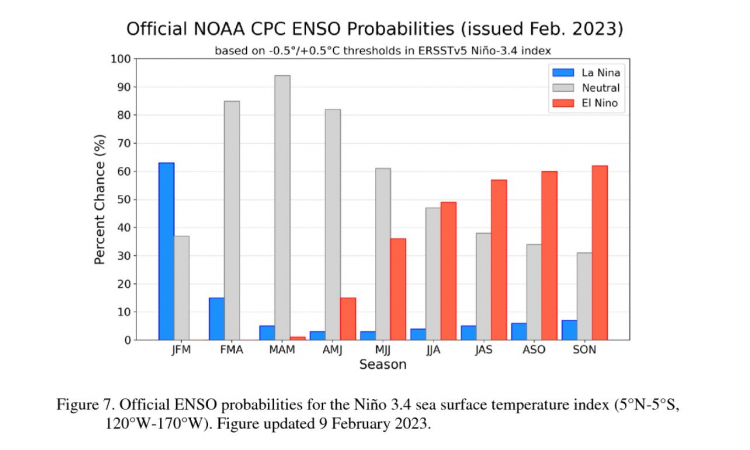By Kellen Severo
The agricultural sector closely follows the occurrence of weather phenomena such as La Niña or El Niño because of the impact they can have on the distribution and regularity of rainfall.
The Climate Department of the United States government has updated the projection for the occurrence of La Niña and El Niño phenomena in 2023.

According to the National Oceanic and Atmospheric Administration (NOAA), in the coming months, the probability of occurrence of the La Niña phenomenon will drop from 15% in the February-March-April quarter to less than 10% between March-April-May.
From April onwards, the chances of El Niño will start to increase, dropping from 15% between April-May-June and reaching over 60% probability between September-October-November.

The agricultural sector closely follows the occurrence of climate phenomena such as La Niña or El Niño because of their impact on rainfall distribution and regularity.
In La Niña years, the South of Brazil is traditionally affected by lower rainfall volumes and a tendency for crop failures, as seen in 2023.
In Rio Grande do Sul, corn is the crop most punished by drought.
According to the National Supply Company, there are losses of up to 100% in some areas, such as the West border and Missões, due to high temperatures and water deficit.
Soybeans are also suffering from the lack of rain.
On the other hand, areas of the Cerrado and Matopiba are favored with humidity, which led Conab to predict a record soybean harvest of 152.9 million tonnes.
In other words, despite the presence of La Niña and the drought problems in Rio Grande do Sul, the other areas had favorable weather conditions and should harvest a bountiful harvest.
With El Niño, the scenario is different since there tends to be more rainfall in the South of Brazil and less rainfall in areas of the Center-North.
The El Niño phenomenon, if confirmed of low intensity for 2023, may negatively impact soybean productivity in the Brazilian average.
The conclusion is from a study done by Céleres consultancy, which has followed the impact of La Niña or El Niño phenomena on expected crop productivity for 32 years.
Enilson Nogueira, the company’s analyst, explains:
“If confirmed, it would be considered a low-intensity El Niño. In our model, [soybean] productivity would be 1.8% lower than expected, or – 1.1 bags/hectare, in the Brazilian average for soybeans.”
“The negative effects of El Niño/La Niña dissipate in the national average. When the South region breaks down, Cerrado does well and limits such effects and vice-versa.”
“It generates a relevant positive result for consumer supply strategies and contributes to the food security of the soybean chains.”
With information from Jovem Pan

